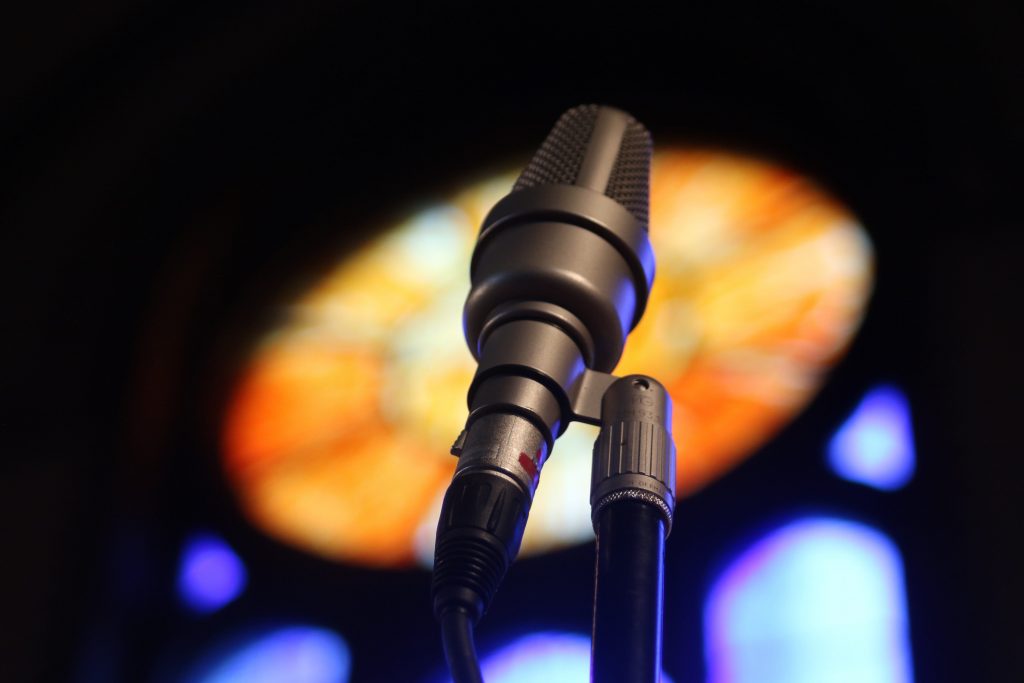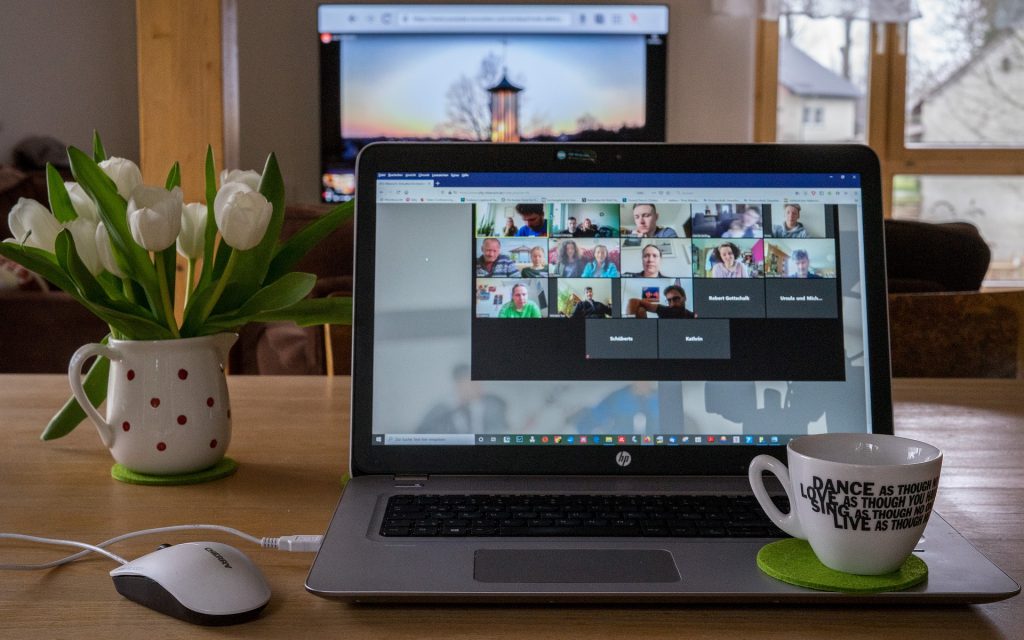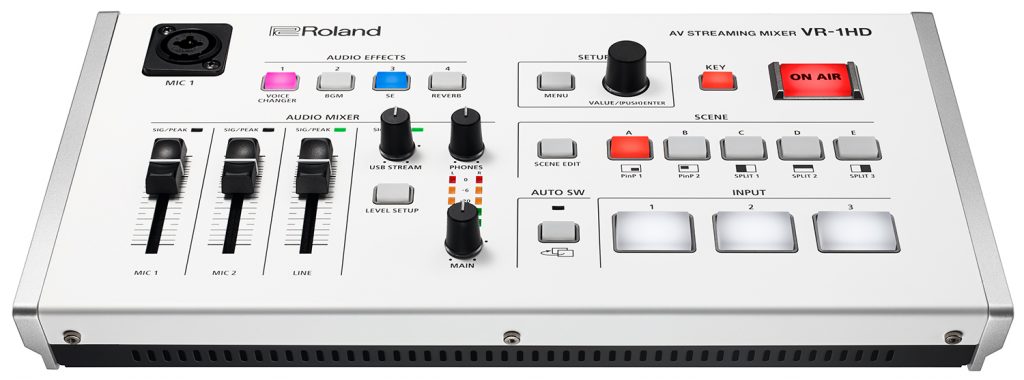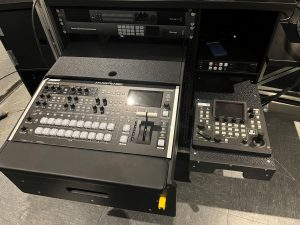- Parishioners in many regions are having to worship from home, and churches are connecting with them via livestreaming.
- One key decision is whether to stream your service live or record in advance and stream on Sunday.
- To capture high-quality voice audio, you’ll want to use a professional microphone.
- Make sure your switcher supports your number of input sources and provides plenty of hands-on control.
We get it. You might be the AV guy/gal in church who’s spent years trying to get the budget approved for livestreaming without success. Now, in the space of a week, you’ve got your worship minister or senior pastor jumping up and down, wondering how soon it can happen. A lot has changed in a very short period.
With the current need for social distancing, parishioners in many regions are having to worship from home, and churches are connecting with them via livestreaming. Large churches have been livestreaming for years, and for them, it’s been business as usual. On the other hand, many small churches have now given it a crack for the first time—and quickly reached the limits of their knowledge and equipment.
With this article, we’re here to walk you through some of the challenges and opportunities that livesteaming presents, and hopefully demystify the process a bit.
Opportunities Abound
First, the opportunities. When people need to stay at home, they still want to hear your church’s message. And now is an amazing opportunity to speak into peoples’ lives. Just think about how many more people have gotten to experience church in recent times thanks to the internet.
The challenge, and your church’s first responsibility, is keeping your members connected, nurtured, and encouraged. How do you do that? Livestreaming to the rescue.

The challenge, and your church’s first responsibility, is keeping your members connected, nurtured, and encouraged.
Live or Almost Live
One key decision to make is whether you’re going to stream your service live—with no safety net—or record your service in advance and then stream it at the scheduled time on Sunday. There are advantages and disadvantages to either approach.
Going ahead with a genuinely “live” livestream provides a truly spontaneous experience for your members at home. Yes, there will be the occasional mistake or technical hitch, just like there is every Sunday. But no one cares—it’s all about conveying the heart of the message and that sense of connection.
Pre-recording a Sunday package section-by-section means you can capture multiple takes and edit the content after the fact. But this will also add a good number of hours in post-production to achieve a finished product. This process can get quite onerous unless you have volunteers willing and able to put in that extra work.
A Fast and Easy Method
A faster and easier way of recording ahead of time is live via the output of a video switcher (which we’ll talk about in more depth coming up). This allows you to capture everything in a single pass with high production quality, eliminating the need for video and audio editing after the fact.
Whatever way you choose, it’s best to stream the content at a scheduled time on Facebook, YouTube, or Zoom, and not simply upload it there like you might a family holiday video. Being “live” on these platforms means you’ll always get better engagement with your church members. The sense of sharing the experience with others at the same time encourages more views, longer viewing sessions, and more interactive comments.
To learn more about livestreaming on the platforms mentioned above, check out these articles:
Let's Start Streaming
Livestreaming can be as basic as opening Facebook on your smartphone, selecting Live Video, pointing your camera in the right direction, and relying on your 4G connection to stay solid for the duration of the sermon. If this describes the extent of your experience with livestreaming, you may already be aware of some serious limitations.
First up, you really need better audio quality. Clear, present spoken word communication is utterly crucial for those at home accessing your stream on a computer or mobile device. Bad audio will be the first reason people switch off or zone out. Your smartphone’s internal microphone can’t deliver the quality needed, and there’s no way to easily incorporate an external mic directly.
Secondly, you need to find a way of including sermon slides, such as verses of scripture and illustrations that would normally be projected on the displays in the auditorium. A smartphone can’t accept a second video input on its own, so you’re out of luck.
To achieve something more acceptable, you’ll need to invest in some hardware. But don’t panic—it won’t break the bank, and you won’t need an engineering degree to figure it all out.
Clear, present spoken word communication is utterly crucial for those at home accessing your stream on a computer or mobile device.
Bringing Your Sources Together With A Video Switcher
Now that the smartphone is back in your pocket, let’s put a Handycam or DSLR camera on a tripod and put it to work instead. The camera will likely have an HDMI output. And the computer you use to run your graphics program (like Pro Presenter, Easy Worship, or similar) will also have an HDMI output, even if it’s via an adapter in Mac world.
You may decide to run a second camera—good idea. A locked-off wide shot gets boring very quickly. Having an alternative camera view will increase the viewability of your livestream production to no end.
To capture high-quality voice audio, you’ll want to use a professional microphone. Most likely, you already have one or more that you regularly use during your services.
So now you have two or three video sources and a mic. To combine them, this is when you need some kind of video switcher (also known as a “vision mixer”). A video switcher will accept multiple video sources and allow you to seamlessly switch between them in real-time.

The first and most important criterion for selecting a video switcher is the number of video and audio input sources it can accept. Next is hands-on control, which makes the switcher easy for anyone to operate. In a world that relies so heavily on volunteer operators, we all know that ease of use for any new equipment is of paramount importance.
Small-format switchers can be quite inexpensive. But don’t be fooled into simply choosing the cheapest—after a few weeks of frustration, you’ll regret it. Inexpensive video switchers typically have very little hardware control. They’re fiendishly hard to work with because the settings are hidden down in menu “rabbit holes.”
Find a video switcher that’s within your budget—but make sure it supports the number of input sources you have and provides plenty of hands-on control.
It’s worthwhile discussing your church’s needs with a pro. They’ll ask questions about your requirements that you’ve probably not thought of yet, saving you money later. You know what they say: you don’t know what you don’t know. So it’s always a good idea to talk to an expert if you can.
It’s worthwhile discussing your church’s needs with a pro. They’ll ask questions about your requirements that you’ve probably not thought of yet, saving you money later.
Other Features To Look For In A Switcher
Beyond the basics, you’ll want to make sure the video switcher you choose offers the right complement of advanced features. This will leave you room to grow once you’ve hit a groove, after you get over the initial stressful “whatever it takes” period of livestreaming church services the first couple of times.
Support for Multiple Image Resolutions
When you combine video from various cameras and computers, it’s possible that their video resolutions won’t match. Some switchers don’t compensate for this, and you may get distorted images from one or more connected sources as a result. A more feature-rich switcher will have an automatic “image scaler” on board to make all the sources work together, ensuring you can switch between them and maintain a great-looking 16:9 livestream output.
Enhance Presentations with Text and Effects
You may want to overlay lyrics for your worship music, or split the screen horizontally or vertically at times to have two different video sources displayed at once. Or for a youth service, you might want to experiment with visual effects. Full-featured switchers have these capabilities built in, ready to access as you get more comfortable with livestreaming.
Easy Connection with a USB 3.0 Webcam Output
The video switcher connects to your computer, which will then communicate the switcher’s live output to your streaming service. Look out for a video switcher with a USB 3.0 webcam output—this provides a direct connection without the need for additional hardware, and makes it easy for your computer to accept the video and use it.
Extra Audio Inputs
To capture a microphone directly, choosing a switcher with a dedicated mic input is a must. In addition, you should also look for one that offers at least one stereo line input. On a basic level, this allows you to connect an external audio source for blending music with your feed. And if your church normally uses a large audio mixer to blend multiple mics, music, and other sound sources in the house, you can connect one of its bus outputs directly to the switcher for a broadcast feed.
An appropriately priced and feature-rich video switcher will be a sound investment that will benefit your church for many years to come.
A Solution For Today—And The Future
While social distancing, livestreaming is the best way to stay connected with your congregation every Sunday. But after things get back to normal and everyone is back in the pews together, it will still remain a powerful tool—letting you reach those who are unable to attend in person, and spread your message beyond the local community. An appropriately priced and feature-rich video switcher will be a sound investment that will benefit your church for many years to come.
About The Roland VR-1HD
Whether you’re a church tech, creator, gamer, commentator, or presenter, Roland’s VR-1HD makes it easy to livestream with high production quality. Powerful, affordable, and simple to use, it lets you broadcast dynamic multi-camera livestreams with amazing picture and sound that easily outshines basic livestreams from mobile phones or static webcams.
The VR-1HD has three worry-free HDMI inputs that accept a variety of HD and computer-based video resolutions. This lets you connect, switch, and stream different sources—including cameras, laptop presentations, gameplay, and even smartphones and tablets—with no fussy setup to worry about. And with USB 3.0 webcam connectivity, you’re able to connect directly to your computer via a single cable.
Audio from different sources can be blended with the two studio-quality XLR microphone inputs and a stereo line input. And best of all, the VR-1HD is designed for live broadcasting, with dedicated controls and a top-mounted mic input (great for a gooseneck mic) that lets you go hands-free and headset-free while livestreaming.






